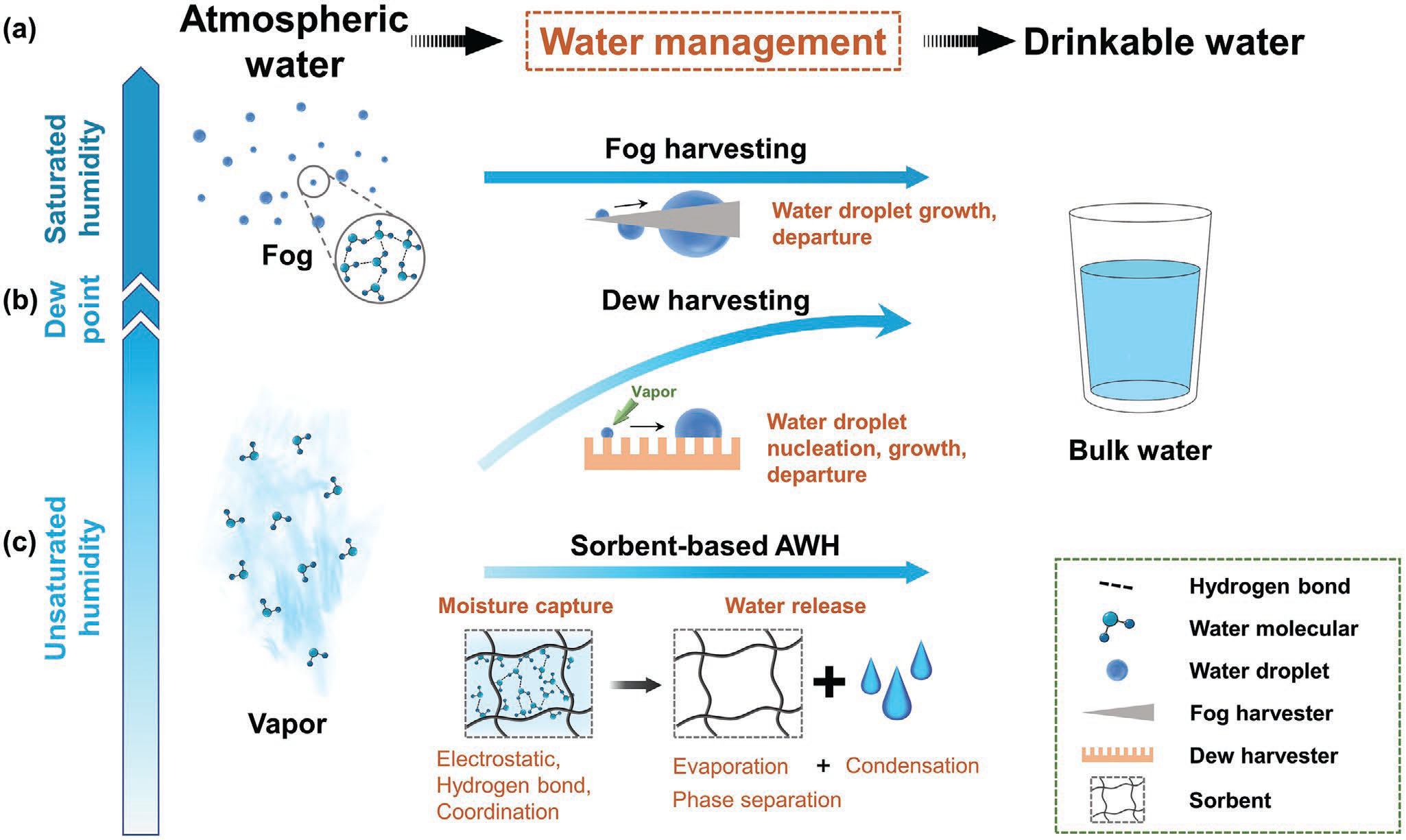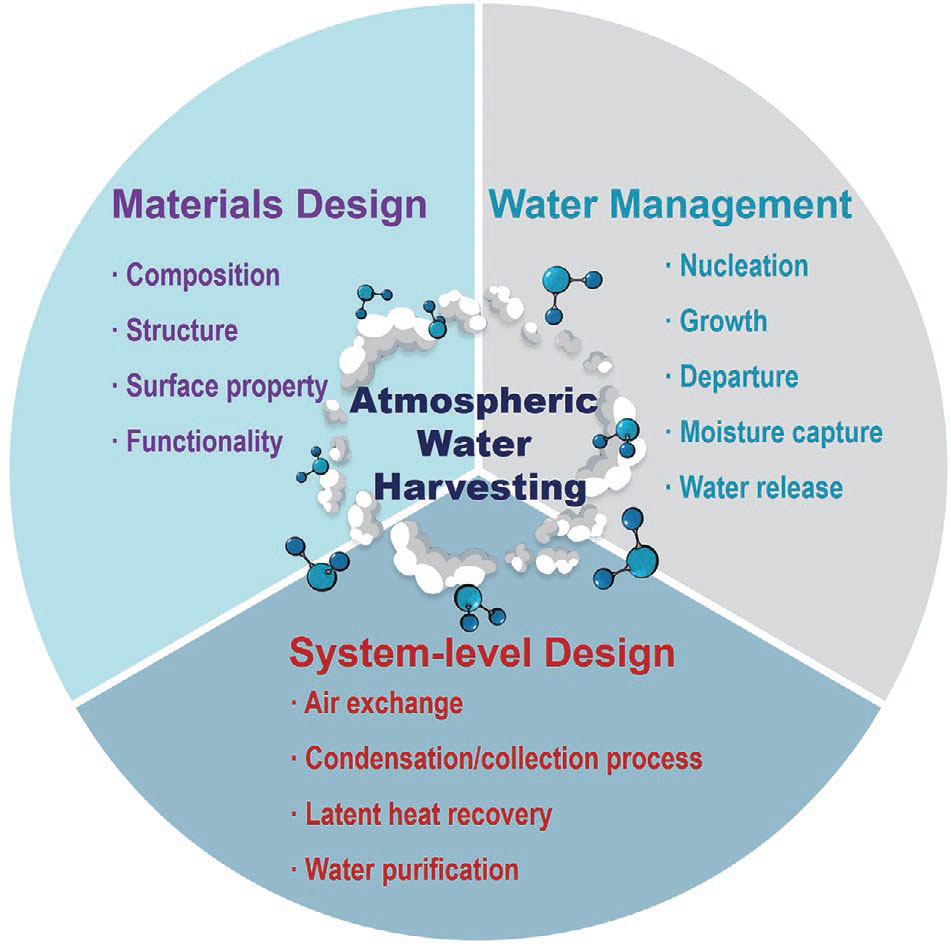| Feb 24, 2022 | |
Materials design for atmospheric water harvesting |
|
| (Nanowerk Spotlight) Only 30% of all freshwater on the planet is not locked up in ice caps or glaciers (not for much longer, though). Of that, some 20% is in areas too remote for humans to access and of the remaining 80% about three-quarters comes at the wrong time and place - in monsoons and floods - and is not always captured for use by people. The remainder is less than 0.08 of 1% of the total water on the planet (read more: "Nanotechnology and water treatment") | |
| And while it seems like getting something for nothing, you really can get drinkable water right out of the driest of desert air. Even in the most arid places on Earth, there is some moisture in the air, and a practical way to extract that moisture could be a key to survival in such bone-dry locations. Scientists estimate that at any one instant, the Earth's atmosphere contains about 12 900 cubic kilometers of water vapor. Extracting water from the air, that is, atmospheric water harvesting(AWH), becomes a promising alternative technology to produce freshwater. | |
| Atmospheric water harvesting can be achieved through three different approaches: fog collection, dew harvesting, and sorbent-based AWH. | |
| Fog collection technology directly harvests tiny water droplets in the air without the need of electricity. However, it requires the existence of fog, which mostly occurs only in coastal or mountainous regions. | |
| Dew harvesting achieves AWH by creating the dew point (the temperature at which the air is saturated with water vapor) using dehumidification equipment with cooling components. However, cooling the air below its dew point consumes enormous energy and causes low energy efficiency, especially in hot and dry climates. | |
| Sorbent-based AWH was developed for unsaturated humidity environments and allows the spontaneous capture of free water molecules in the air via adsorption or absorption. The interaction between water and sorbents leads to cooling-free water condensation. For example, metal-organic framework (MOF)-based materials can capture water molecules from an arid environment with a relative humidity lower than 30% without cooling accessories (read more: "Harvesting water from thin air with metal-organic frameworks"). | |
 |
|
| Schematic illustration of atmospheric water harvesting (AWH) technology. a,b) AWH at saturated humidity. Fog harvesting and dew harvesting are effective ways for AWH at saturated humidity. The key water management steps for dew and fog water management are the nucleation, growth, and departure of the water droplet. c) AWH at unsaturated humidity. Sorbent-based AWH can capture water molecules in an environment with unsaturated humidity. The key water management steps for sorbent-based AWH are the moisture capture (electrostatic, hydrogen bond, or coordination) and water release (evaporation + condensation, or phase separation) processes. (Reprinted with permission by Wiley-VCH Verlag) | |
| As illustrated in the figure above, various water evolution processes such as rapid droplet nucleation (for dew harvesting), fast droplet growth, and efficient droplet departure (for fog/dew harvesting), effective vapor capturing and energy-efficient water release (for sorbent-based AWH), can be realized to facilitate the AWH. By taking advantage of materials engineering tools, the water-materials interactions can be tailored to achieve effective and efficient outcomes. | |
| A perspective article in Advanced Materials ("Materials Engineering for Atmospheric Water Harvesting: Progress and Perspectives") presents the recent materials engineering-enabled water management strategies for improving AWH performance at different working conditions (i.e., saturated humidity, dew point, and unsaturated humidity). | |
| The authors from The University of Texas at Austin first summarize novel structural and material designs – MOF harvesters, polymeric hydrogels, hygroscopic salt-based composites – for water management (water droplet nucleation, growth, and departure) in fog and dew harvesting, such as anisotropic structures and inhomogeneous surface wettability. | |
| Then they introduce advances in structural engineering of moisture sorbent materials and discuss some representative works, especially their innovative designs on tuning the water-material interactions to achieve molecular level water management for efficient moisture capture. | |
| Overall, the authors point out that tailoring materials-water interactions at the molecular level plays a vital role in realizing high water uptake and low energy consumption of AWH systems. | |
 |
|
| Future perspectives on future developments in atmospheric water harvesting technologies. (Reprinted with permission by Wiley-VCH Verlag) | |
| Concluding their review, the researchers point out that system-level development is also essential to push AWH toward a real-life application: How to integrate advanced material into a device without sacrificing its intrinsic performance remains very challenging. | |
| They suggest that system engineering that facilitates air exchange, improves heat transfer, and promotes condensation/ collection may help fully exert materials??? capability, thus improving the overall AWH performance. Also, combining other functionalities, such as water purification and disinfection, anti-fouling, solar energy or low-grade heat utilization, etc., could promote the development of practical AWH. | |
 By
Michael
Berger
– Michael is author of three books by the Royal Society of Chemistry:
Nano-Society: Pushing the Boundaries of Technology,
Nanotechnology: The Future is Tiny, and
Nanoengineering: The Skills and Tools Making Technology Invisible
Copyright ©
Nanowerk LLC
By
Michael
Berger
– Michael is author of three books by the Royal Society of Chemistry:
Nano-Society: Pushing the Boundaries of Technology,
Nanotechnology: The Future is Tiny, and
Nanoengineering: The Skills and Tools Making Technology Invisible
Copyright ©
Nanowerk LLC
|
|
|
Become a Spotlight guest author! Join our large and growing group of guest contributors. Have you just published a scientific paper or have other exciting developments to share with the nanotechnology community? Here is how to publish on nanowerk.com. |
|
